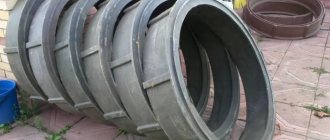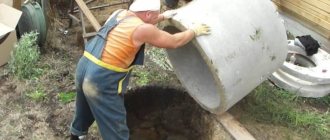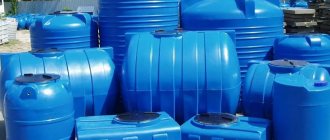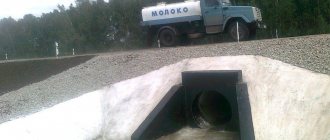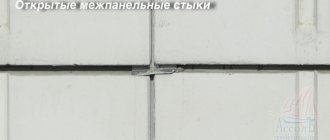For a long time, concrete rings served as an indispensable material when arranging a private plot. But with the development of technology, plastic rings for wells or sewers are increasingly replacing concrete products. Let's figure out what plastic products exist, what sizes and features they have, and what factors to consider when choosing.
Polymer sand rings for a prefabricated well Source content-online.ru
Classification methods: types and sizes
Plastic rings are used in arranging communications of all types. Therefore, if we take into account the scope of application, we can select products for a well (drinking water), for a septic tank or sewerage system. It is convenient to divide products according to the material from which they are made; in this case the following options are possible:
- Made from polyethylene. The main advantages of plastic are its long service life and indifference to significant temperature fluctuations (from -50 to +70°C), which allows its use in most climate zones. Polyethylene rings have a multilayer structure, which increases their strength and resistance to aggressive environments; installation does not require special skills and knowledge.
- Made from polypropylene. Durable and resistant to abrasion, polypropylene plastic rings can withstand temperatures up to +120-140°C without changing their performance properties. Polypropylene is a chemically resistant material that is not afraid of aggressive organics; To increase frost resistance, stabilizing additives are introduced into its composition.
Rings and additional elements Source montagtrub.ru
- Made from fiberglass. Fiberglass, which is part of the polymer, gives the products particularly high wear resistance. They are not subject to corrosion, are durable, do not break down when working in aggressive environments, and are safe to maintain since they do not conduct electricity. The main disadvantage is the high cost.
The dimensions of plastic structures are standardized as follows:
- Inner diameter (with and without bottom): 60, 68, 80, 90 cm.
- Outer diameter: 65, 73, 85, 95 cm.
- The height varies depending on the type of product (stacked or solid), from 20 to 150 cm.
- The lid is selected according to the size of the neck. The internal diameter varies from 55 to 90 cm, the external diameter - from 60 to 95 cm.
Purchase of materials and methods of laying plastic rings
Only after studying the technical conditions and preparing the design component can you begin purchasing materials. You need to purchase components based on the required depth of the well, taking into account the possible or desired diameter. When determining dimensions, subsequent use must be taken into account.
Helpful advice! If there is uncertainty about the correctness of the preparatory stage, it is better to contact an organization involved in the installation of plastic wells to draw up a plan and estimate. Even minor errors can make it impossible to operate the device normally in the future.
It is not necessary to choose expensive plastic rings for a septic tank. Polyethylene (they are the cheapest) of medium thickness (20-30 mm) will be sufficient. It is better to buy a plastic drainage well from a more resistant material - polypropylene, since it will most likely be located in a place where external loads are inevitable.
Depending on the composition and mobility of the soil layers, rings can be laid in an open or closed way.
You need to dig a shaft for a well in an open way, giving the hole a round shape
The open method is used if the soil is not loose or mobile. A shaft of the required depth is dug, having a size 10-15 cm larger than the diameter of the rings. If the well is drinking, a filter of sand, pebbles or geotextile is placed at the bottom. An appropriate tray is installed in a sewer system or well for other purposes:
- solid;
- with profiling in the form of grooves;
- distribution;
- passable.
A pipe is assembled from individual plastic rings and lowered into the well shaft. The pipe is leveled, and the space between the plastic and the soil is filled with small pebbles, sand or a mixture of both. The neck is mounted, the hatch is installed.
Helpful advice! There is no need to fill the space with cement mortar. This will make it much more difficult to repair or reconstruct the well in the future.
Plastic does not release harmful substances into the water, so concrete and metal pipes of old wells are replaced with polymer ones
The closed method of installing a well is advisable where the soil is loose. The shaft is dug to the depth of one ring, which is subsequently installed. Then the soil is selected so that the ring lowers under its own weight. To use this method, it is important that the method of connecting the rings is simple - threaded or grooved. After laying the entire pipe, the necessary bottom is poured from sand, pebbles or cement mortar. Next, the space between the soil and the walls of the shaft is filled, and a hatch is installed.
Types of standard sewer manholes for plastic wells
An important condition for long-term and normal functioning of the well is the correct selection of the hatch. The standardization is based on the load that a plastic well structure can presumably withstand. There are different types of hatches that can withstand the load:
- Up to 1.5 tons. They are used in areas where there is no constant mechanical pressure. These can be pedestrian paths, lawns, lawns.
- Up to 12.5 tons. Installed on sidewalks and in parking lots.
- Up to 25 tons. Designed for installation on city roads.
- Up to 40 tons. Withstands the load of constant traffic flow, including trucks. Located on highways.
Plastic hatches for wells are made of resistant polypropylene, which does not fade in the sun, does not corrode and can withstand a wide range of temperatures
Depending on the set of well components, hatches are installed:
- directly to the mine;
- on the neck;
- to the discharge ring.
Only hatches that can withstand a load of up to 1.5 tons can be installed directly on the shaft. For other types, any installation method is applicable. When installing a well, it should be taken into account that the weight that the cover can support must correspond to the thickness of the plastic rings for the sewerage.
Benefits of use
The use of plastic in the installation of communications simplifies the progress of work and subsequent operation due to its improved physical and chemical characteristics. The advantage of polymer rings for wells is expressed in the following advantages:
- Improved physical properties. Plastic, unlike ring concrete, does not require maintenance or repair. The design maintains original performance characteristics over a wide range of operating temperatures.
Comparison of the characteristics of plastic and reinforced concrete Source seti.guru
- Inertness The polymer is resistant to any organic and inorganic substances contained in water and soil, as well as to most technical compounds (chemicals, oils).
- Improved wear resistance. Plastic retains its strength for 45-50 years of service.
- You can refuse additional waterproofing. You will not have to spend additional time and money, as is the case with a concrete structure that needs to be treated with waterproofing compounds. To ensure that the system does not allow water to pass through, it is necessary to follow the installation technology.
- Light weight. A standard concrete ring weighs about 600 kg, while a plastic ring weighs less than 50 kg. Transportation and installation are greatly simplified.
- Environmentally friendly. Modern polymer materials are completely safe for health. Due to their inertness, they do not emit harmful substances under any operating conditions.
The drainage well protects the adjacent area from flooding Source novoe-mesto.ru
The only thing in which plastic products are inferior to their concrete counterparts is cost. However, the owners who made the choice in favor of plastic were convinced that it was completely justified, since it eliminated many problems during the operation of the products:
- They do not need to be cleaned, since the smooth walls do not form plaque suitable for the development of microorganisms.
- They maintain good tightness and are not afraid of soil movements.
- They are not afraid of periodic freezing and thawing.
- If necessary, they can be equipped with additional accessories, for example, a hatch, a ladder, a neck.
See also: Catalog of companies that specialize in water supply, sewerage and related work
Plastic sewer well: features of the polymers used
Rings for wells (sewage, switching, drinking water and septic tanks) are usually called in one word - “plastic”. Since wells made from this material are used for various industrial purposes, in everyday life, to create drainage systems, since they function in different soils and under different mechanical and thermal influences, they are made from different polymers.
For the manufacture of plastic well rings use:
- polyvinyl chloride;
- polyethylene;
- polypropylene;
- polymer-sand mixture.
Despite the overall high performance indicators, the materials still differ in a number of features. Wells made of polyvinyl chloride are fire-resistant. This material is resistant to various chemical influences. Polyethylene products withstand temperature changes best; freezing and thawing water does not deform the rings.
Polypropylene is used for installation in places where there is constant mechanical or vibration impact on the structure. The material is plastic and most wear-resistant. The polymer-sand well is characterized by almost absolute tightness.
The complete tightness that polyvinyl chloride rings have prevents waste from seeping into the ground.
Note! When choosing rings for a plastic well, be sure to pay attention to the material of manufacture and compare its qualities with the conditions of use and purpose of the well.
For a drinking well, in the absence of problematic soil, you can buy polyethylene rings. They are inexpensive and quite suitable in terms of functional features. If the soil is unfavorable, you should buy a polymer sand well.
For a commutation well that is subject to constant mechanical stress (for example, when a car drives in, drives out, or is parked), it is better to purchase polyvinyl chloride rings. Their price is the highest, but only this material can withstand constant loads without consequences.
You can buy inexpensive rings for a septic tank, made of polyethylene. The accumulation of gases does not deform or negatively affect the condition of this polymer. The costs of purchasing more wear-resistant material are unnecessary.
Well rings made of polymer-sand composite.
The constantly growing demand is ensured by the choice of offers. Today, plastic rings for wells can be purchased at any store that sells plumbing equipment and plastic products. Selecting a pipe from the desired material is not difficult.
Functionality and scope
The main way of using polymer products in the private sector is in wells for drinking water. Another area of use is drainage and sewer systems, and in private households - a septic tank.
The bottom is made of the same material as the body Source seti.guru
Plastic rings intended for sewerage can be divided according to purpose into the following types:
- Observations. Without them, normal functioning of sewer pipelines is impossible. With their help, they carry out maintenance, monitor the condition of the system, and deliver equipment. They are installed at places of rotation, connection, change in slope or diameter.
- Absorbent. They are needed where it is impossible to drain wastewater, for example, in private septic tanks. Drainage material (crushed stone, broken brick, gravel) is poured into their bottom.
- Water intakes. The accumulated water is diverted somewhere else: into a drainage system, into an open reservoir or ditch. For water intake wells, it is important to have a sealed plastic cover. It helps to avoid sewer overflow when water comes in quickly (for example, after heavy rain).
When there is no central main line nearby, an autonomous sewer system can be built without the use of a septic tank. To do this, the bottom of the well, mounted from plastic rings, is supplemented with a kineta - a special tray with pipe connection points. The system will allow waste to be discharged evenly.
A well for sewerage, next to it is the bottom (sink) Source ytimg.com
With the help of plastic well rings it is convenient to restore dilapidated structures, concrete, brick, earthen. To update the source, just select rings with a smaller diameter and install them in one of the following ways. The space between the old and new walls is filled with sand.
Comprehensive restoration of drinking wells
Drinking wells fail for various reasons. Most often, the walls of a structure lose their former tightness, after which surface runoff begins to flow into it like a river. Sometimes the opposite happens: the well dries up hopelessly and water appears in it only under very rare circumstances.
If there is an old abandoned well on your site, it can be turned into a sealed tank with a capacity of 1.2 m³, designed to store drinking, rain or melt water. This will again be helped by plastic inserts of the “ROTOLINE” series with a height of 2000 mm, additional elements for them, as well as special adapters that provide a hermetically sealed insertion of pipes with a diameter of 25 to 160 mm.
Installing them in an abandoned well is not so difficult, but why not give an empty source of water a full second life...
Construction and details
By design, polymer wells are divided into the following types:
- Prefabricated. They are assembled directly at the installation site using the groove connection principle. Prefabricated products are lightweight and can be installed alone.
- Monolithic (seamless). A convenient option for arranging a drinking well. The polymer pipe is immersed inside the aquifer; it is sealed enough to protect the water from contamination.
- Welded. Made from polyethylene, used for sewerage.
- Any plastic well, regardless of the material of manufacture, includes the same set of parts:
- Bottom. Durable and thick cast part. The bottom can be blind, through or tray (the latter has guides for diverting the flow).
Construction of a sealed plastic well Source oboiman.ru
- Well (chamber). The main element is in the form of a smooth or corrugated pipe of large diameter with thick walls.
- Hatches, covers. Appearance depends on the purpose. The blind hatch prevents debris, groundwater and sediment from entering the well shaft. Lattice models are used in combination with storm drainage systems.
- Ring. Designed to regulate the height of the polymer well.
- Caisson. It is used to create a waterproof working chamber in water-saturated soil or to protect the well from contamination.
- Accessories. Necks (most often present on inspection wells), reinforced steps for wells.
There are more specialized varieties. For example, a well for a well has a relatively small body diameter. Additionally, it is equipped with corrugations that help to effectively withstand soil pressure; Stiffening ribs also help with stability.
The neck is an essential part of many products Source oboiman.ru
Requirements for the placement of a plastic sewer well
When determining a location for a sewer well, you need to know whether other communications are laid close so as not to damage them during the preparation of the mine. It is necessary to remove the well from growing trees at least two meters. Elements of the sewerage system must be laid at a distance of 1.5 m from the water supply pipes.
The plastic sewer well must be located no further than 10 meters from the sewage outlet and at least 3 meters away from the building. It is better to buy plastic rings for a sewer well with a diameter of at least 900 mm. This size will make it accessible for repair and revision work.
Regardless of the purpose, private or public use, the construction of sewer wells must be carried out according to certain rules and requirements.
How to restore a well with plastic rings
Plastic well rings are rarely used for self-installation. With their help, concrete structures that have lost their tightness due to long-term use and wear, broken installation technology, or soil pressure that has caused displacement of parts are brought back to life. The occurrence of a problem is judged by the following signs:
- Damages or defects in a shaft that are visible to the naked eye.
- A sharp decrease in water level (unless this is due to seasonal changes or, for example, to a deeper mine dug in the neighborhood).
- The water became cloudy and a foreign smell appeared.
- The bottom silts up, impurities appear (sand, clay, soil), cleaning does not help.
The operation of the well can be restored using polymer rings. Repair work is carried out in the following order:
- The well frame (ground part) is dismantled.
- The water is pumped out using a pump.
- If necessary, the walls of the well are disinfected.
- Remove debris, sand, and silt from the bottom.
Composite blank for a well Source seti.guru
Restoration begins three days after preparation, for which the following actions are performed:
- Plastic rings are connected into a single structure. If the bottom surface is not smooth enough, it is first updated by adding sand, crushed stone or broken brick.
- Additionally, the seams can be treated with a sealant (for example, silicone).
- The space formed between the plastic and the soil is filled with sand.
- After completing the work, wait until the well fills on its own. Then install a drainage pump and pump out the water several times until it becomes clear.
A backfill is made between the plastic and the soil. Source ytimg.com
Features of repair and maintenance work
Drinking concrete wells (even with constant cleaning) need major repairs or replacement after 25-30 years. With the advent of plastic rings, repairs have become less problematic. We will talk about a new plastic well for drinking water in place of the old concrete one.
Signs indicating the need to replace a concrete well include:
- the appearance of an unpleasant smell of dampness or rottenness in the water;
A common problem that causes well repair is blockages.
- the presence of clay impurities (the water has become cloudy);
- critical drop in water level;
- significant destruction of concrete rings.
It is necessary to select rings for repair, adhering to the requirement that they will be 10-15 cm smaller than concrete ones. The remaining concrete shaft is a definite barrier to the action of moving soils. Considering that concrete rings will continue to deteriorate and, possibly, aggravate the effect of the soil, the material of plastic rings for updating the well must be chosen that is durable and wear-resistant.
The assembled pipe is lowered inside the concrete pipe, the gap is filled with a mixture of sand and pebbles. If there is intense groundwater and leaks in the old structure, it is advisable to additionally seal the joints of the rings with silicone.
It is important! Cleaning the bottom and replacing the filter layer must be done before lowering the plastic pipe into the shaft. Otherwise, the bottom will only be partially replaced, which will certainly affect the quality of water purification.
It is best to clean the well in the cold season: late autumn or winter
There are still a sufficient number of wells preserved, where the shaft is made using brickwork. It most often has a rectangular or square shape. Such designs are typically used for telecommunications networks, so they are shallow.
If the size of the well allows, it can be restored using plastic rings, following a certain sequence of work:
- remove the hatch;
- dismantle the top layer of masonry;
- clean the well from collapsed debris;
- mount and lower the pipe assembled from the rings (taking into account the switching channels);
- fill the voids between the brick walls and the pipe;
- install the new hatch in the appropriate manner.
It is possible to repair wells using a one-piece structure. Its main advantage is that it is absolutely airtight. In this way, it is advisable to repair shallow wells - up to 500 cm. The lower edge should be installed on a flat surface. When deciding whether to repair or install a well using a solid structure, you must take into account the thickness of the pipe and compare it with the load.
Breakdowns can occur as a result of unqualified maintenance or due to wear and tear of the well elements
How to make the right choice
When choosing polymer rings for a sewer or drinking well, you must be guided by the following criteria:
- The price of polymer products depends on the type and quality of the material, wall thickness, dimensions and design features (for example, the number of pipes).
Different types of drainage wells Source colodec.ru
- Monolithic and prefabricated models are offered on the market; the latter are more expensive.
- A monolithic body cannot be used in all cases. It is durable, withstands compression well, but is only suitable for shallow mines, and it is impossible to build it up.
- A well of any height can be made from prefabricated products; at the junction of individual elements there is a sealing ring responsible for the tightness. In general, the design is more flexible than a monolithic one, but the more connections there are, the greater the likelihood of leaks.
- Models with pipes save time: you don’t have to cut in the pipes yourself.
Installation of a caisson for a well Source proraboff.rf
Plastic rings for deepening wells
You will not be able to deepen an old well with a reinforced concrete ring of standard diameter (the old reinforced concrete rings “grow” very firmly to the surrounding soil). Using rings of smaller diameter is also not always convenient: reinforced concrete rings are a heavy and rather fragile material. It’s not hard to guess how many inconveniences they will cause to the unlucky buyer during transportation and installation work. But the problem is easily solved by using special polymer rings of the “ECOSYS” series.
We are talking about plastic products intended for complex restoration, sealing or deepening of water intake drinking wells. Also, ECOSYS plastic rings are very convenient to use for the construction of new wells. These products are made of spiral pipe, which allows you to create wells of standard sizes: with an internal diameter of 800 and 900 mm and a wall thickness of 25 mm. At the same time, “ECOSYS” rings have threaded connections, which allows you to create wells of any depth based on them.
After installing the rings, the free space between the walls of the shaft (the walls of the old well made of reinforced concrete rings) is filled with crushed stone, river pebbles or sand. At the bottom of the well, a filter bed is also created from the materials listed above. The tightness of threaded connections is ensured by moisture-resistant silicone sealant, which is applied directly to the threads before twisting the two mating rings. If for some reason you need to strengthen the tightness of the connection, then after twisting the threads, the joints are covered with heat shrink tape or boiled with an extruder.
Plastic rings of the "ECOSYS" series allow you to quickly create a new well or restore an old one, spending a minimum of time, money and your own effort.
Briefly about the main thing
Plastic rings simplify the construction of a drinking well; they eliminate the need to install concrete rings or line the internal walls with bricks. The materials used are plastics with different properties; some are extremely resistant to aggressive environments, others tolerate negative temperatures well.
In the private sector, plastic structures are most often used for the restoration of drinking wells, installation of wells and sewage systems. They can be prefabricated, welded and seamless, differ in size and the presence of additional elements.
Summary
Compared to alternative technical solutions intended for the construction and reconstruction of wells, septic tanks and other hydraulic structures, the products look decent, practical and economically profitable. This is achieved thanks to the following advantages:
- the sizes of plastic rings, inserts and additional elements ensure high-quality and unhindered restoration of wells built on the basis of standard reinforced concrete rings;
- for the restoration of old wooden log houses (Finnish wells), the manufacturer’s assortment includes plastic inserts and rings of reduced diameter;
- All products are made from safe and durable materials that meet the requirements of sanitary and environmental standards (linear polyethylene and HDPE 100).
Simplicity and high quality of assembly are ensured by the design features of plastic rings, wells and inserts: threads cut in production conditions, as well as the presence of special socket connections guarantee the strength, tightness and durability of quickly assembled connections.
Nuances of calculating the required volume of capacity
To organize a septic tank from concrete rings, it is necessary to calculate the volume based on daily water consumption. According to the standards, one permanent resident receives 200 cubic liters of water per day.
Image gallery
Photo from
Specifics of a single-chamber septic tank
Installation of three chambers in one well
Average volume of a two-chamber septic tank
Volume of multi-chamber septic tanks
The first container for settling wastewater should have a volume of at least three times the consumption (200 l) for each person. The second container with a bottom for settling should have a volume equal to 1/3 of the size of the first.
The rules for constructing a two-chamber treatment plant can be found in our other article.
The number of rings can be determined by dividing the volume of the container by the volume of the ring. Their sizes come in small, medium and large.
For the calculation, the parameters of an average-sized ring will be used. KS-10-9 whose internal diameter is 1 m and height is 90. One ring has a volume of 700 cubic liters
For a family of two:
Volume of the first container = (200*2)*3= 1,200 liters. Volume of the second and third containers = 1,200/3 = 400 liters.
Number of rings for two containers = (1200+400)/700= 4 Number of rings for three containers = (1200+400+400)/700= 5
Bottom line: 2 rings for the sump, 2 for the sedimentation tank and one for the drainage well.
For a family of three:
Volume of the first container = (200*3)*3= 1,800 liters. Volume of the second and third containers = 1,800/3 = 600 liters.
Number of rings for two containers =(1,800+600)/700=4 Number of rings for three containers =(1,800+1200)/700= 6
Result: 2 rings for the sump, 2 for the sedimentation tank and two for the drainage well.
Buying the optimal plastic container for a septic tank for sewerage: price of products
On the building materials market you can buy plastic containers for sewage of various sizes and modifications. To create them, special production technologies are used to produce products with improved characteristics. Such material is capable of withstanding severe tensile or compressive loads, which makes it possible to use polymer septic tanks without fear that the soil may damage or deform the container during heaving and movement.
Why is it profitable to buy a plastic sewer container for a septic tank:
- the lightweight structure allows transportation using a regular car;
- a simple installation system does not require the participation of specialists; the installation of a septic tank can be handled by two people;
- low cost of the product;
- inertness to the negative influence of aggressive environments, due to which the effective operational service life is measured in tens of years.
Helpful advice! In order to reliably and efficiently install a plastic waste container, be sure to anchor it to a concrete slab. In addition, you will need to create a clay or concrete backfill around the container. Thanks to this, the septic tank will remain in its place, and will not float like a float in the soil.
Schematic diagram of the installation of a septic tank on the site
Among the disadvantages of plastic waste containers, one can note their fragility under the influence of low temperatures. For this reason, experts recommend backfilling when installing a structure using insulating material.
Features and price of plastic containers for sewage: polypropylene products
Polypropylene is made from polymers. Despite the similar base, this material is much stronger than plastic, due to the inclusion of softening substances that increase plasticity.
The unique composition provides polypropylene products with many advantages:
- resistance to temperature changes;
- resistance to cracking due to temperature changes;
- long service life (about 100 years);
- tightness and waterproofness, thereby eliminating the possibility of contamination of water sources by wastewater;
- high resistance to the influence of steam during system sterilization and exposure to aggressive environments.
Products made of polypropylene have thick walls ranging from 5-20 mm. In addition, the design provides for the presence of stiffeners. These elements prevent the tank from floating and provide additional strength.
Average price of polypropylene septic tanks Maple:
| Model | Capacity, m³ | Dimensions, (height/width/length), mm | price, rub. |
| Klen-3 | 1 | 880/910/1200 | 22000 |
| Klen-5 | 1,5 | 1100/1100/1500 | 30000 |
| Klen-5N | 1,5 | 1100/11001950 | 32000 |
| Klen-7 | 2,5 | 1500/1300/1500 | 40000 |
| Klen-7N | 2,5 | 1500/1300/1950 | 44000 |
Features and price of plastic septic tanks for sewage: polyethylene products
Polyethylene products are made from polymers with the addition of fiberglass threads. Thanks to this, the walls perfectly withstand such negative phenomena as soil movement and swelling. Containers respond well to stretching and smooth compression, but they are afraid of sharp impacts. Forceful impact can damage the tank and cause a crack to appear.
Advantages of polyethylene septic structures:
- light weight of the product;
- a wide choice of configurations, including spherical and square shapes;
- long service life (within 30-50 years);
- resistance to the negative influence of aggressive environments.
Like other plastic products, polyethylene containers are easily damaged under the influence of sudden mechanical loads.
Helpful advice! The storage volume should be selected taking into account the fact that one person needs approximately 1 m³. Thus, for a family of 4 or more people, you will need to buy a plastic sewer container of 5000 l or 5 m³.
Average price for Polex plastic products:
| Dimensions, (length/height excluding neck), mm | Capacity, m³ | Wall thickness, cm | price, rub. |
| 1800/1200 | 2 | 1,8 | 25000 |
| 2700/1200 | 3 | 1,8 | 30000 |
| 3600/1200 | 4 | 1,8 | 39000 |
| 2900/1500 | 5 | 2,5 | 57000 |
| 3400/1500 | 6 | 2,5 | 80000 |
| 4000/1500 | 7 | 2,5 | 87000 |
| 4600/1500 | 8 | 2,5 | 95000 |
Expert advice:
Modern treatment facilities are usually 10% more expensive. These septic tanks are equipped with all the necessary filters for high cleaning efficiency of up to 98%.
Reinforced polypropylene septic tanks have a sealed pump compartment for discharging purified water onto the ground or into a drainage ditch.
A prominent representative of such septic tanks is the Super septic tank Tver, which does not have the above-mentioned disadvantages of a septic tank made of concrete rings. This septic tank is effective, reliable, and unpretentious in operation.
